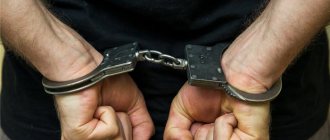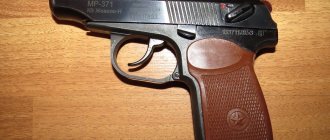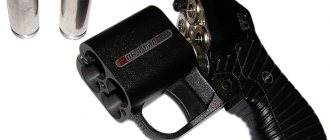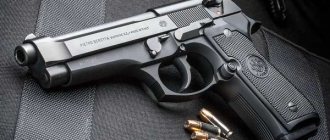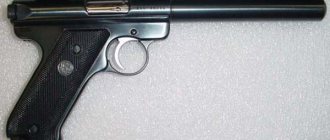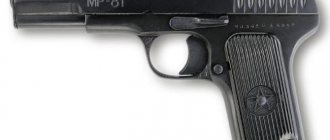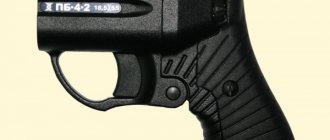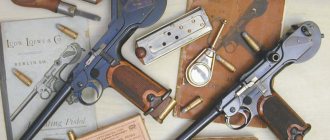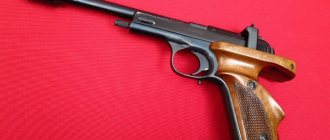American gunsmith-enthusiast Cody Wilson has designed The Liberator pistol, which can be printed on a 3D printer at home. The Liberator, made of plastic, is not detected by metal detectors, which, coupled with the possibility of home production of weapons by anyone, caused dissatisfaction with the American authorities (we have already written briefly about this). The US State Department demanded that the gunsmith remove printable 3D handgun models from the Internet, and senators proposed revising the Undetectable Firearms Act of 1988. Authorities believe that the availability of The Liberator production technology could lead to a new wave of terrorist attacks.
"Liberator"
The 3D printed weapon project started in the United States in early August 2012. Its founder was lawyer Cody Wilson , who, along with several friends, began developing easy-to-manufacture small arms. The project was called Wiki Weapon .
Its main idea is to create three-dimensional drawings of firearms that anyone can download from the Internet. At the same time, the drawings would be distributed on a free basis so that every enthusiast could make their own modifications and improvements to them. The development group led by Wilson called itself Defense Distributed .
For almost a year, nothing was known about the fate of the project, but on May 1, 2013, Wilson assembled the first fully 3D-printed pistol, called The Liberator, and tested it on May 2 at a private testing site in Texas. The weapon was secured to a metal frame, and the trigger was pulled using a strong string. The pistol fired successfully without any visible damage to the frame or barrel. The cartridge used for shooting was .380 caliber (9×17 millimeters).
On May 5, 2013, Wilson fired a plastic pistol while holding it in his hands. This test was also successful.
The Liberator consists of 16 parts, 15 of which are plastic: handle, trigger, two springs, body, exposed hammer, hammer mount, barrel, washer, three body fasteners, hammer fasteners, grip fasteners and trigger return spring . The only metal in the weapon is the firing pin that pierces the cartridge primer - this is an ordinary nail (and it is best if it has a large head).
The pistol was printed on a used SST 3D 3D printer manufactured by the American company Stratasys Dimension , purchased by an enthusiast gunsmith for eight thousand dollars. The weapons are printed from standard ABS plastic (car bumpers, vacuum cleaners, furniture, and sports equipment are made from it).
After printing, all weapon parts are treated with acetone vapor over a water bath to smooth the surface of the components. At the same time, the parts themselves become a little stronger (for example, a plastic barrel after such treatment can withstand up to ten shots before breaking). The production also takes into account the printing technology patented by Stratasys Dimension : the temperature inside the printer chamber, where printing is done, is maintained at 75 degrees Celsius throughout the entire process.
According to the company, 3D plastic models printed under such conditions are more durable and resistant to deformation.
The Liberator can be printed on almost any type of 3D printer that works with ABS plastic: from the Makerbot Replicator for 2.2 thousand dollars to the homemade RepRap, drawings of which and the corresponding software can be found on the Internet. The pistol is currently chambered for the low-power .380 caliber cartridge, created back in 1908 by John Browning. Such cartridges are only sufficient to hit a person in exposed parts of the body at a short distance. .380 caliber cartridges are widely used by law enforcement agencies.
When testing The Liberator with a more powerful 5.7x28 mm cartridge, the pistol shattered into small fragments.
The Liberator is a single-shot weapon with quick-change, reusable barrels. Nothing is yet known about the pistol’s combat rate of fire, but, obviously, it is extremely low. The simplicity and relative reliability of the design is ensured by the absence of a reloading mechanism. The group of enthusiasts Defense Distributed has not yet announced anything about the guaranteed service life of weapons. Wilson spent about 20 thousand dollars on the project, which were collected exclusively through donations through the peer-to-peer electronic payment system Bitcoin. This money, in particular, went towards renting premises, purchasing a printer, software and a metal detector frame to test The Liberator for detectability.
External links [edit]
| Wikimedia Commons has media related to Distributed protection . |
| Wikisource has some original text related to: Defense Distributed |
- Official website of Defense Distributed
- DEFCAD
- Weapons Development Blog Wiki
- Defcad IRC channel Twitter
- Fosscad Liberator Repository
- Anarchism portal
- Legal portal
- Freedom of speech portal
- Internet portal
- Libertarianism portal
- USA portal
- Military portal
Ideology
Cody Wilson, a self-described anarchist and radical libertarian, named the gun of his own invention after the World War II single-shot smoothbore pistol FP-45 Liberator. This weapon consisted of 23 extremely easy to manufacture parts. The pistol was produced in 1942 in the USA, and it was planned to be used to arm the partisan movement in German-occupied European territory. In particular, about 500 thousand FP-45s were planned to be dropped from aircraft over occupied territory, but in reality only 25 thousand Liberators were transferred to the French Resistance in Great Britain.
While developing the pistol, an American enthusiast said that its distribution via the Internet would destroy the intention of the American authorities to introduce complete control over the circulation of weapons. In addition, according to Wilson, The Liberator will blur the line between gun control legislation and information censorship on the Internet.
The enthusiast explained this idea to Forbes as follows:
“Wherever there is a computer and the Internet, a gun can appear.”
On a more philosophical note, the Wiki Weapon project aims to show that technology can circumvent any law "until governments simply become useless."
Rice. 1. Here and below are photos from the official Defense Distributed blog.
Wilson believes that by being able to independently download gun designs from the Internet and print them out on a printer, the world will become freer, since governments will not be able to endlessly adjust laws to keep up with newer technical innovations.
“People will be able to create their own sovereign space... And the government will always be on the margins and screaming, ‘Hey, wait a minute,'” Wilson said, noting that this is the similarity of his pistol with the Liberator of World War II. After all, in fact, the German occupiers in the occupied territories were the very government whose power was planned to be destroyed.
Rice. 2.
Among the main goals of sending FP-45 pistols to Europe, according to Wilson, was to undermine the morality of the Nazi occupiers, a kind of psychological operation.
“The enemy noticed that weapons for the partisans were falling straight from the sky. Our operation will be even better. We have the Internet,” said Wilson. Electronic drawings of The Liberator were published by Defense Distributed on May 6, 2013.
Reception [edit]
Original copies of the Liberator have been permanently acquired by the Victoria and Albert Museum, [15] [16] [17] and a replica of the cannon is on display at the London Science Museum.
In an article in The Register
Lewis Page ridiculed the Liberator, stating that "it is no more a pistol than any other very short piece of plastic pipe is a 'gun'" and compared it to a 1950s zip gun. [18]
The television series How to Sell Drugs Online (Fast) depicts one of the main characters typing and using Liberator for self-defense. [19]
Kampfpistole, Sturmpistole ("Combat pistol", "Assault pistol") Germany, 1942-1943.
Pistol Kampfpistole / Sturmpistole, Germany
Compact pistol-grenade launchers for fighting infantry and even tanks are very strange, but perhaps the most practical weapons on our list. The fact is that such systems were not only developed, but also used by Nazi Germany during the Second World War.
The idea arose back in the 30s. The military thought: what if they fired small grenades from a regular 26mm rocket launcher? It could be quite a good weapon for close combat! Then, several types of fragmentation grenades were designed for the single-shot Leuchtpistole signal pistols of the 1928 model. There were very small ones, in the form of the usual signal cartridges, and more powerful over-caliber ones, which were loaded from the muzzle. The range of the shot varied from 70-80 to 200 meters, the radius of destruction by fragments was 20-30 meters.
Why World War II “hunting” weapons are disappearing from stores
When firing a grenade from the hands there was a risk of injuring the hand, so a folding shoulder rest was added to the rocket launcher and equipped with a primitive sight. But another problem remained - the Leuchtpistole aluminum barrels turned out to be too weak for over-caliber grenades, so before firing a special brass sleeve had to be inserted into them, which made loading difficult.
In 1942, based on the signal Leuchtpistole, a pistol-grenade launcher with a steel rifled barrel, the Kampfpistole, was developed. The combat characteristics improved, but the weapon became expensive and lost its versatility - the “Combat Pistol” could not fire signal flares. A compromise solution was the Sturmpistole - a special upgrade kit for rocket launchers, consisting of a steel rifled barrel insert, a folding stock and a removable sight. There are archival photos of the use of pistol-grenade launchers, but reliable data on the scale of their production and use could not be found.
MBA Gyrojet rocket pistol, USA, early 1960s
MBA Gyrojet, USA
The creators of this pistol were probably fascinated by Edmond Hamilton's Star Kings or were victims of mid-20th century rocket fever. That was the time when the military and politicians believed in the omnipotence of missiles and wanted to replace artillery, aviation with them... and everything that was possible. And in the early 60s, engineers from the American company MB Associates thought: why not a pistol? – and they made a Gyrojet pistol, which shoots small steel rockets.
This solution, in theory, made it possible to obtain an effective and almost silent weapon - instead of the usual roar, there was only a hiss, like a flat tire. Structurally, the Gyrojet was an aluminum pistol 30 cm long and weighing 620 grams with a permanent six-place magazine. When the trigger was pressed, the trigger hit... the nose of the rocket, and it moved back, impaling the primer on the stationary firing pin, the powder charge ignited, and the projectile went forward, simultaneously cocking the hammer.
The Long Barrel of Discord: How to Travel with a Weapon and Not Lose It
The maximum speed of the rocket was 380 m/s, but it was achieved 20 meters from the barrel exit; the rocket accelerated to a speed of 300 m/s at about 7 meters, and left the barrel at only 30 meters per second. If you consider that the main pistol distances are 1-10 meters, then as a self-defense weapon the Gyrojet is so-so. The accuracy of shooting was also not very good: at 100 meters the spread of hits exceeded three meters.
The most interesting (and almost incredible) thing is that, according to American sources, Girojets were purchased by American officers and were allegedly even used during the Vietnam War. Although it was not possible to find data on the results of their use.
Hunting non-automatic pistol TP-82, USSR, 1982
Pistol TP-82, USSR
This hybrid of a sawed-off shotgun, a pistol, and an ax was intended as a survival weapon for Soviet cosmonauts and for some time was part of their carryable emergency supply. It was assumed that with such “wonderwaffe” space explorers (if they happened to land in wild and deserted places) would be able to shoot wild animals, hunt, chop wood, lay paths in the thickets and give signals to search groups.
The idea for the pistol was suggested by Alexei Leonov in 1979 during a trip to the Tula Arms Factory. The fact is that in 1965, after flying on the Voskhod-2 ship, Leonov himself and his partner Pavel Belyaev landed in the snowy taiga and spent two days there awaiting evacuation. The astronauts almost died, and the emergency kits they had did not allow them to solve the problems of survival.
How the Maxim machine gun became the world's first weapon of mass destruction
In 1982, Tula gunsmiths presented three models at once: a self-loading rifle, a revolver and a three-barreled pistol. The choice fell on the latter. Structurally, the TP-82 is a three-barrel non-automatic pistol 360 mm long with a wooden fore-end for the second hand. At the top there are two smooth barrels of 32 caliber (12.5x70 mm) horizontally, at the bottom there is a rifled barrel of 5.45 mm caliber. “Smooth” cartridges allow you to hunt small game – duck, pheasant, hare, etc. – plus shoot flares. A rifled cartridge with a special expansive bullet is designed for animals weighing up to 200 kg.
In David Bolotin’s book “The History of Soviet Weapons and Ammunition” it is said that the “extent of destruction” of this bullet is approximately 10 times greater than that of the 7N6 automatic bullet of 5.45x39 caliber. Alexey Leonov said in one of his interviews that the TP-82 rifled bullet had an initial speed of under 1000 m/s and could kill a bear. However, reference books give more modest figures - 820-840 m/s; there is no information about bears.
The “space pistol” is reloaded like a simple hunting “breakdown”. As a butt, you can attach a canvas case with a triangular machete to it - the place where the “butt” rests on the shoulder is protected by a special steel heel. When assembled, the structure looks very inconvenient. There is no information about the practical use of the complex, and in 2016, cosmonaut Sergei Ryazansky said that the pistol was no longer included in the emergency reserve. By the way, American astronauts do not take firearms on flights.
